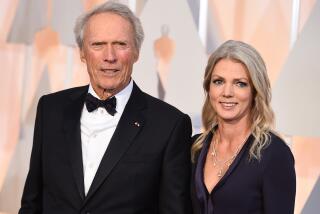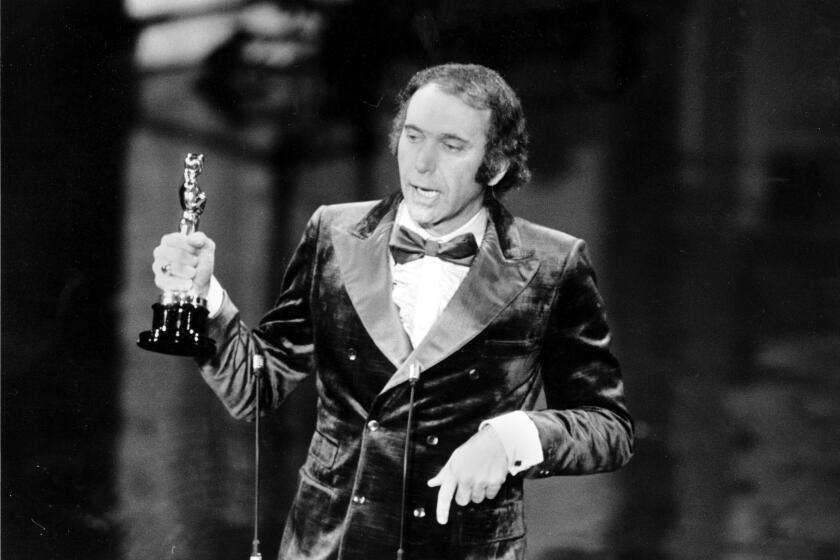Another Year, Another Oscar Strategy : Movies: Gilbert Cates finds a different set of circumstances for this year’s Academy Awards, his second as producer of the annual awards show.
Gilbert Cates, director of such much-admired films as “I Never Sang for My Father” and “Summer Wishes, Winter Dreams” as well as hours of television, including “Call Me Anna,” the story of Patty Duke’s difficult life, is these days up to his story board as producer of the Academy Award telecast.
It is Cates’ second year as producer and he undertook it again only after prayerful consideration. Criticizing the show is a national pastime and the producer traditionally is a prime target. But last year’s show, with its live remote telecasts from five countries, was generally thought to be one of the best in recent years.
“It’s shocking how the world has turned. Last year when we did the foreign remotes, the Berlin Wall was down. We were pals with the Russians and there were all the changes in Eastern Europe. And this year. . . .” Cates trails off.
The show’s theme this year is a celebration of the movies’ first century. There are several landmark years from which to date that first century. The academy has chosen 1891 because it was then that Thomas Alva Edison wrote to George Eastman at Kodak in Rochester, asking him, if he could, to make film in long continuous strips. Eastman could and the movies became possible. There will be one satellite remote this year, from Paris in connection with the film centenary.
Hardly catching his breath after the Oscarcast, Cates on April 8 will move into another large challenge, as dean of UCLA’s newly combined School of Theater, Film and Television. The old bifurcation of the former from the two latter no longer makes any sense, Cates agrees strongly. Cates himself has done a good deal of work on Broadway, and he first did “I Never Sang for My Father” on stage, as well as “You Know I Can’t Hear You When the Water’s Running” (though he did not do the film).
“There’s been an artificial distinction, and it’s quite sad,” Cates said at lunch a few days ago. “We’re getting more and more into a multimedia age. Almost no property exists for one medium only. ‘Driving Miss Daisy’ was a play that became a film, ‘Phantom of the Opera’ is a stage musical that’ll become a film.”
At the Directors Guild, of which Cates has been president, there are workshop classes for members. The most requested classes, according to Cates, are sessions on working with actors. It is an activity (and an obvious link between theater and film and television) that Cates is likely to want to emphasize at UCLA.
“I’ve always detested the term filmmaker ,” Cates says. “Hate it. Who makes a film? A lot of people make the film, a great many people.” It is a collaborative medium, but as Cates suggests, the vision of the filmmaker as a man with a megaphone doing it all still persists among students, as its own kind of summer wish and winter dream, quite at odds with reality.
Cates makes an analogy between what film study ought to be and his own undergraduate career as a competitive fencer. He started fencing at Dewitt Clinton High School in the Bronx and, he says, you spent three months of exercise just getting in shape to fence. Then you spent hours and days lunging at suspended “doughnuts” to sharpen your aim before you faced a human opponent.
He went on to fence at Syracuse University. “You learned the foil first, mastered it, then went on to the epee and the saber. You took it in stages.” The analogy is clear. You work up from the basics.
Cates is hesitant about any specific ideas he has for the school. He inherits an existing faculty and traditions and is happy to learn as well as teach. But it seems clear that Cates feels his own grounding in theater served him well as he moved along to television and films. “That grounding is not only good, it’s essential,” he says.
Cates remembers, wryly, visiting the Yugoslav national film school in Belgrade on a delegation that included Keith Carradine and Robert Duvall. “There was a room, maybe 20 by 30, at the top of the building, where all the film students gathered--all 18. I asked the dean why there weren’t more. ‘Ah,’ he said, ‘but that’s all we need.’ ” No such imposed constraints apply here, and the U.S. graduates thousands of film students each year.
Cates is not about to change that. But, he says: “you’re planting seeds, and maybe you can plant better seeds. And fertilize them better,” he adds, with a fairly mischievous smile.
More to Read
Only good movies
Get the Indie Focus newsletter, Mark Olsen's weekly guide to the world of cinema.
You may occasionally receive promotional content from the Los Angeles Times.






